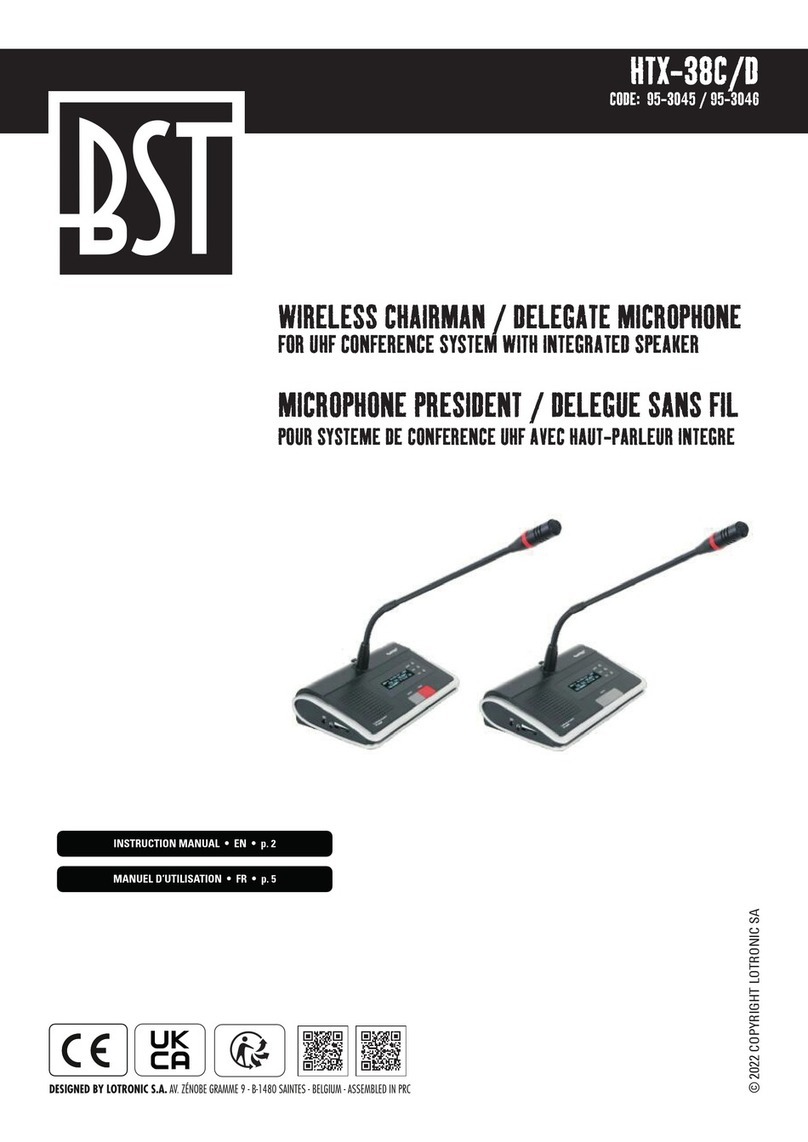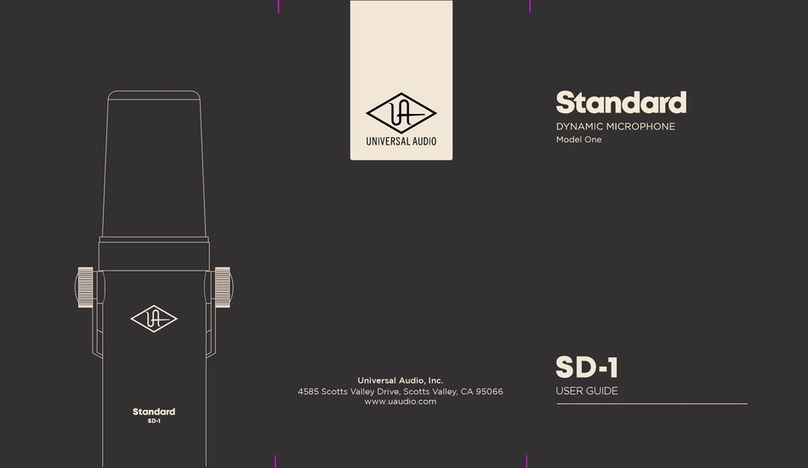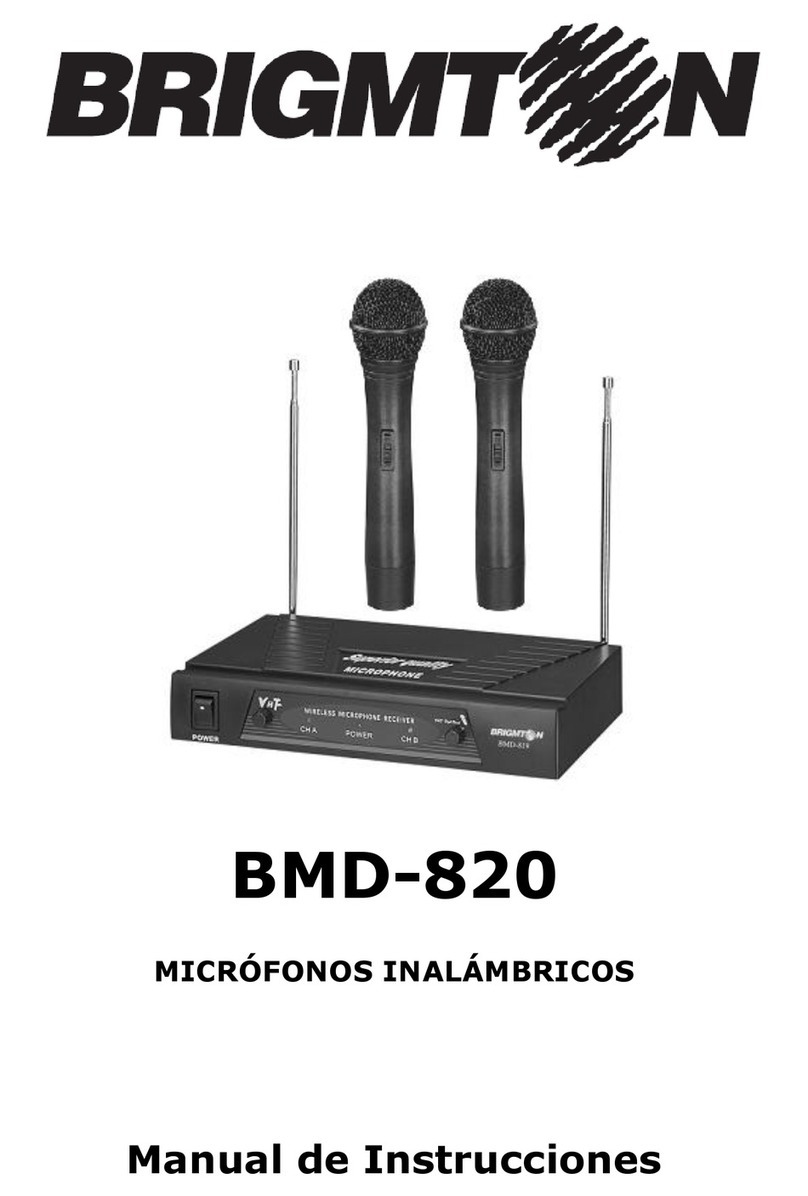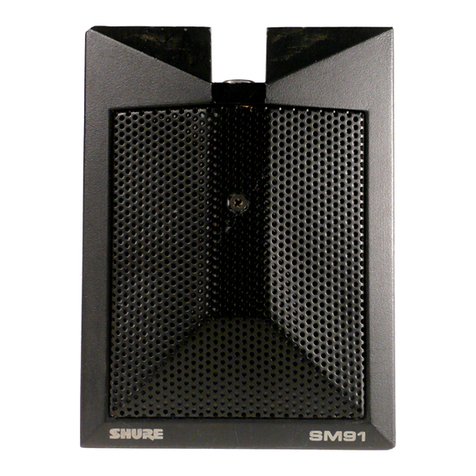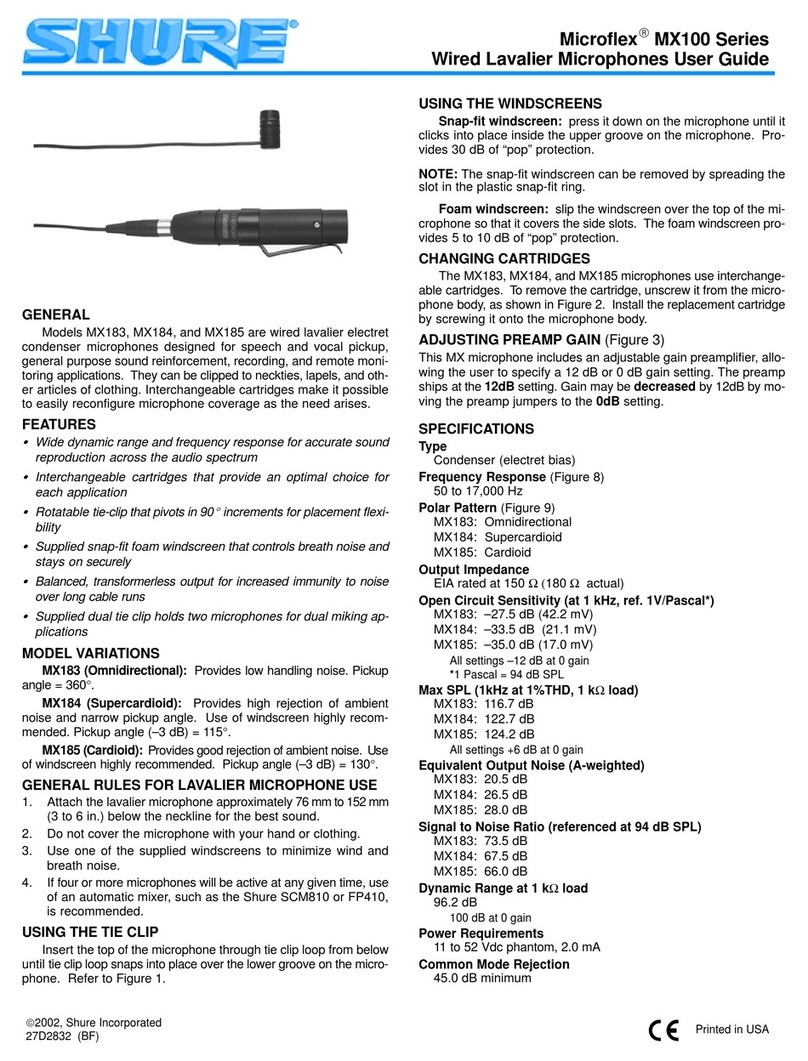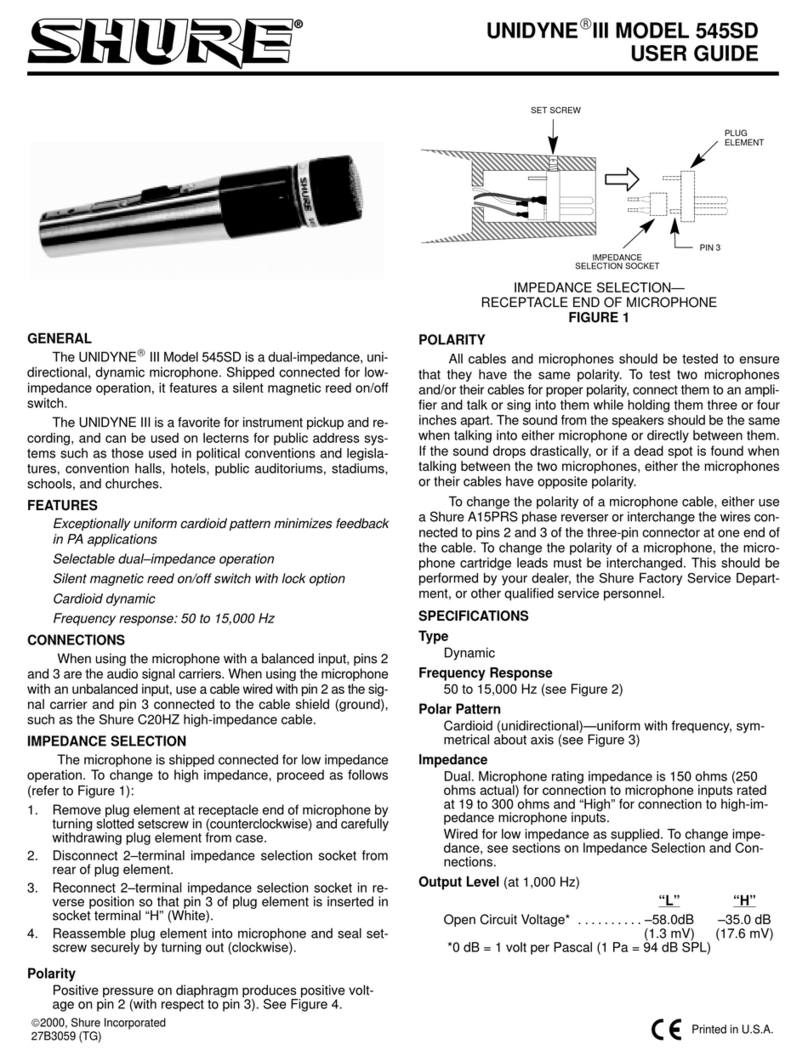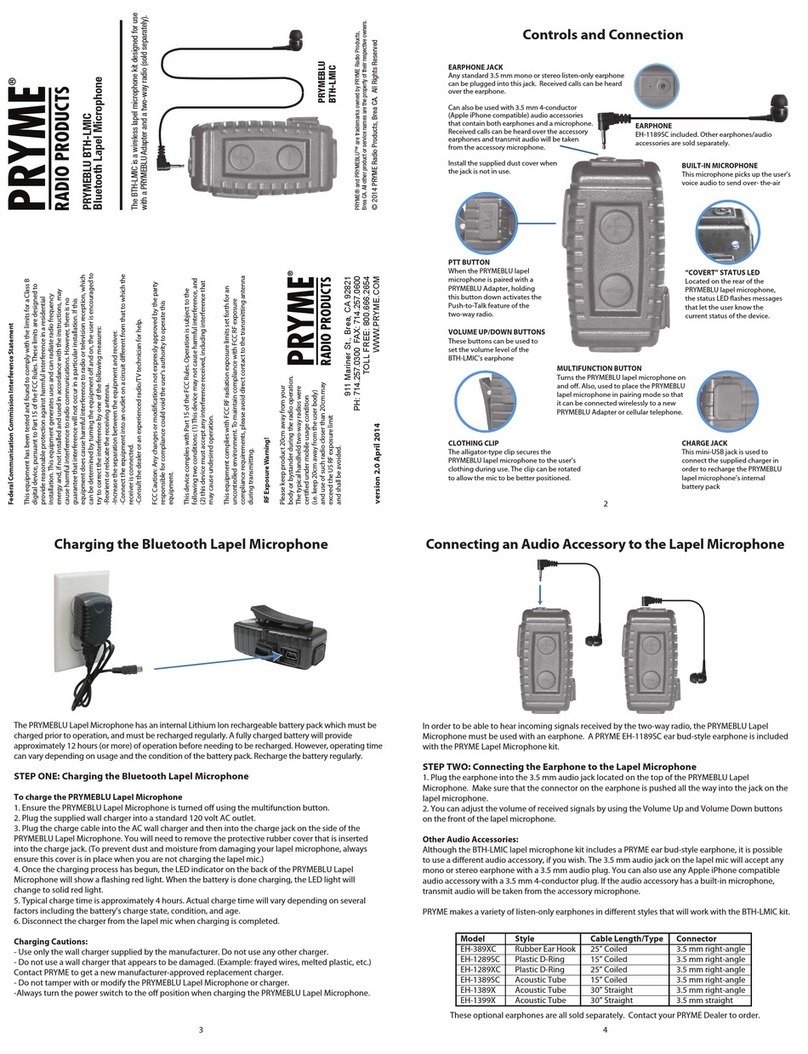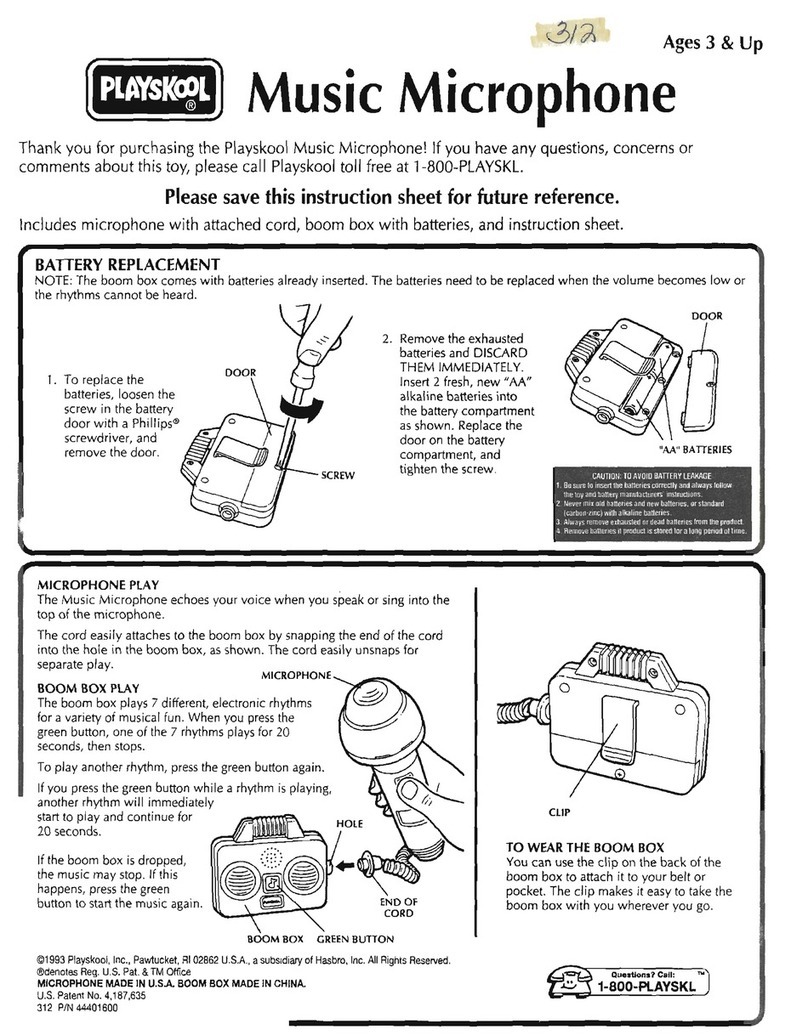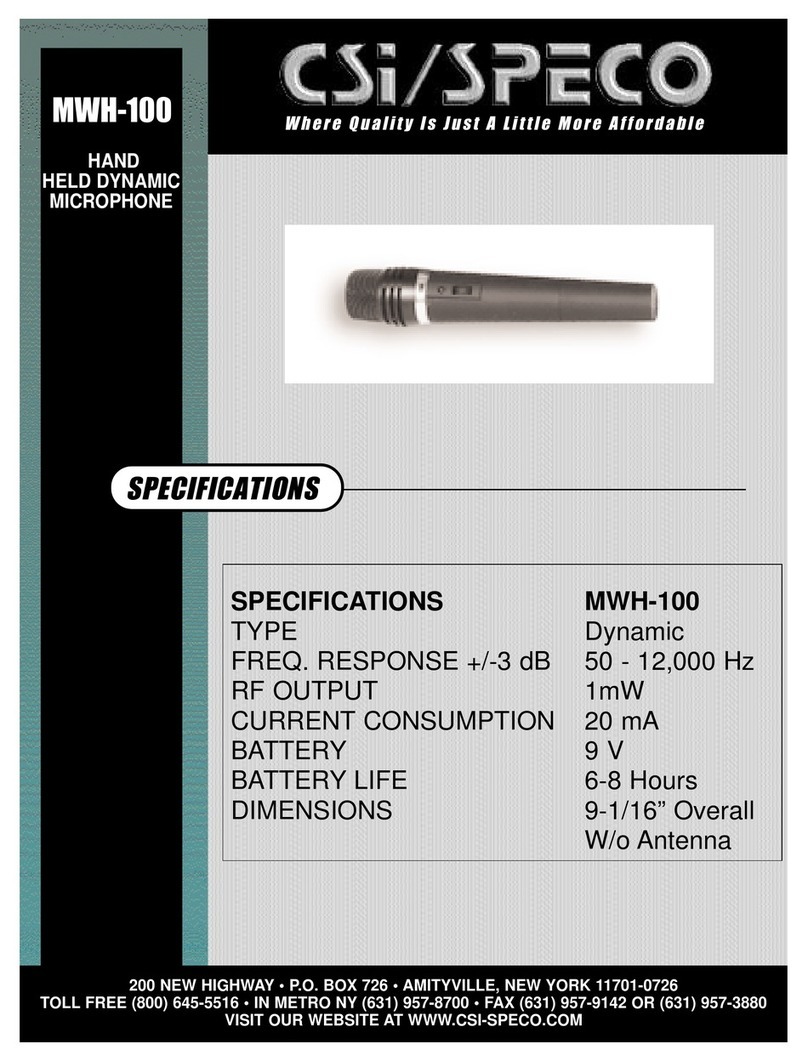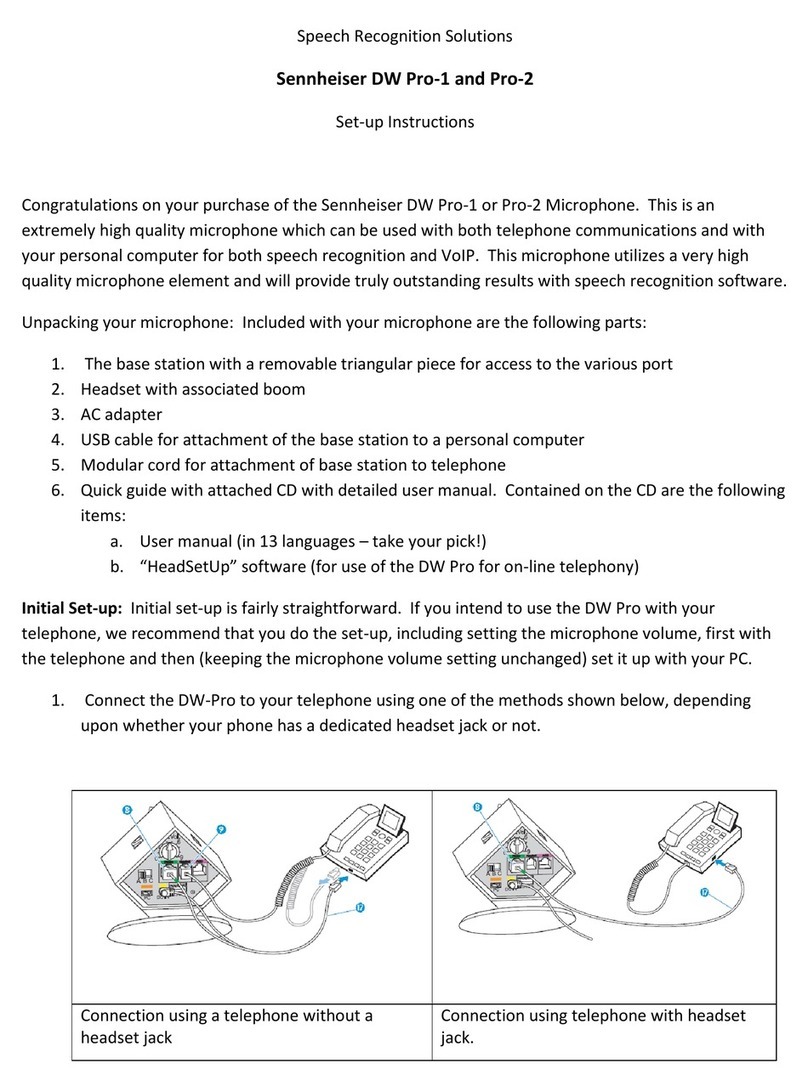George Neumann TLM 170 R User manual

1
22388040
1
Betriebsanweisung
fur
das
Kondensatormikrophon
TLM 170 R
Operating
Instructions
for
the
TLM 170 R
Condenser
Microphone
MArz
1993
G,
1
N~urn
..
rm
[jrrD't
841'1
•
Ch,'tc"l'f,Otl
I ' 0 1
000
Be"'l1
6'
• r
004')
JO
? 59 93 0 • F
.l,oI
00
"9
30
25993
108 '
rl)'
• 1
8.1
!::tq5
MoU.t"
d

Seite/Page
Feld
ubertragungsfaktor
8
mV
/
Pa
= - 42
dB
reo The outputsensitivity is 8 mV/Pa = -
42dB
reo
lV
/Pa.
1. Kurzbeschreibung
1.
A Short Description 2
lV
/Pa. Das Mikrophon wird mit 48 V. 2.6 mA phan-
The
microphone
is
phantom
powered
fr
om
48
V.
tomgespeist (DIN 45 596 bzw. IEC 268-15
).
2.6 mA (IEC 268-15/DIN45596
).
2. Das Kondensatorrnikrophon TLM 170 R
2.
The TLM 170 R Condenser Microphone 3 Die Einsprechrichtung ist seitlich. die Vorderseite The axis of maximum sensitivity
is
at right angles to
2.1
Einige Zusatzinformationen zum Betrieb des 2.1
Addi~onal
Hints for the Operating wird durch das Neumann-Emblem gekennzeichnel. the main axis of the microphone. The front is desig-
TLM 170 R of the TLM 170 R 5 nated
by
the Neumann insignia.
Auf der Ruckseite befinden sich
2.2 AusfOhrungsformen und
Beschaltung
des
2.2 Microphone Versions and At the back of the microphone may be found
Mikrophonausgangs Output Wiring 6 -
der
Richtcharakteristikumschalter
:
fOnf
Schall-
stellungen und eine sechste zur
Fernumschal-
-the directional characteristic selectors switch: five
2.3 Mikrophonkabel 2.3 Microphone Cables 6 tung (s. S. 8), switch positions plus a sixth one for remote con-
3. Stromversorgung
3.
Power Supply 7 -
em
schallbarer
Hochpafl
, - 3 dB-Grenzfrequenz trol (s. page 8).
30 Hz (.,UN") oder 100 Hz. - a switchable high-pass;
-3
dB
point at 30 Hz in
3.1 Phantomspeisung
3.1
Phantom Powering 7 -ein 10 dB-Dampfungsschalter.
UN
position, or 100 Hz.
3.2 Betrieb mit Netzgeraten 3.2 ac Supply Operation 7 - a 10
dB
attenuation switch.
3.2.1 Konventioneller Betrieb 3.2.1 Conventional Operation 7 Der
schwenkbare
BOgel ist
k6rperschalldammend
3.2.2 Betrieb mit fernsteuerbaren 3.2.2 Operation with Remote-controlled angebrachl. Er kann bei Bedarf abgenommen oder auf
The
swivelable mountingbracket is elastically mount-
Richtcharakteristiken Directional Characteristics 8 die andere Seite des Mikrophons montiert werden. ed.
1t
mayberemoved
or
maybemounted to
theother
3.2.3 Sammelspeisung 3.2.3 Central Powering 9 side of the microphone when required.
3.3 Batteriespeisung 3.3 Battery Powering 9
3.4 Betrieb an unsymmetrischen
oder
3.4 Operation with Unbalanced or Center
mittengeerdeten Eingiingen
Tap
Grounded Inputs 9 2. Das Kondensatormikrophon
2.
The TLM 170 R Condenser
TLM 170 R Microphone
4. Demontage der elastischen BOgel-
4.
Disassembling the Elastic Stand-mount
halterung Bracket
10
Das Kondensatormikrophon TLM 170 R ist ein Stu-TheTLM1 70 RCondenserMicrophone is a studiomi-
5. Technische Daten TLM 170 R 5. TLM 170 R Technical Specifications
11
diomikrophon der Serie fet 100 mit
fOnf
umschaltba- crophone of the fet 100 series, featuring five switch-
ren Richtcharakteristiken. able directional characteristics.
6. Frequenzgange und Polardiagramme
6.
Frequency Responses and Polar Patterns 12 Die Buchstaben TLM stehen
fOr
.Transformatorloses The letters TLM stand for
Transformerless
Micro-
Mikrophon". Der Zusatz R weist auf die Fernbedien· phone.
7. Zubeh6r
7.
Accessories 14 barkeit (Remote)
der
Richtcharakteristiken hin (sie- The suffix R denotes Remote control facilities of Ihe
he Abschnitt 3.2.2). directional characteristics (see chapter 3.2.2).
Der zur
Leistungsanpassung
der
Mikrophonaus-
1.
Kurzbeschreibung 1. A Short Description gangsspannung an die Betriebsspannung ublicher-The transformer which normally couples
Ihe
micro-
weise
verwendete
Ubertrager
ist im
TLM
170
R phone's output to the supply voltage. has been re-
Das Kondensatormikrophon
TLM
170 R ist ein Stu- The TLM 170 R is a studio condenser microphone durch eine elektronische Schaltung er
setZ1
. die - wle placed
inthe
TLM 170 Rbyan electronic circuit which,
diomikrophon
mit
den
fOnf
umschaltbaren
Richt- featuring five switchable directional characteristics: like a transformer. maintains the excellent
common
ein Ubertrager -
fUr
eine gute Unsymmetriedampfung
charakteristiken Kugel. Breite Niere. Niere, Hyper- omni, wide cardioid, cardioid. hyper-cardioid and li- moderejection(CMR).lnterierenceinduced
in
thebal-
sorgt. Daher werden Stiirsignale. die auf die symme-
niere und Achl. gure-B. trische Modulatlonsleitung elnwirken. wie gewohnt anced modulation line is therefore
suppressed
as
Es zeichnet sich aus durch Its mosl important features are unterdriJckl. usual.
besonders niedriges Eigengerausch und h6chste especially low selt noise level combined with hig- Die Eigenst6rspannung des TLM 170 R konnte ge- The self-noise level of the TLM 170 R is lower than
Aussteuerbarkeit, hest oulput capability.
genuber
vergleichbaren
Mikrophontypen
gesenkt
comparable microphone models while its overload
werden. wobei das Mikrophon Schalldruckpegel von capability extends to 144
dB
SPL
, providing, without
ein neu entwickeltes, transformatorloses Schal· • a newly developed transformerless circuit. 144 dB unverzerrt Obertragt und ohne Umschaltung anyswitch-over,adynamic range of130dB (DIN/IEC
tungskonzept,
einen
Dynamikumfang von 130
dB
zur VeriOgung
651
).
extraordinarily true sound transduction free of co- stellt (nach DIN
fl
EC 651).
besonders
saubere. freie und
veriarbungsfreie
loration. The TLM 170 R has its axis
of
maxi
mum
sensitivity
KlangObertragung. Das Kondensatormikrophon TLM 170 R wird von der arranged radially; i.e. at right angles to the axis of its
The microphone has a balanced. transformerless Seite besprochen. Seine Vorderseite ist durch
das
body
.
Neumann-Emblem gekennzeichnet. die Umschalter
Das Mikrophon hat einen symmetrischen, Obertra- outpul.
gerlosen Ausgang. The 3-pin Switchcratt connector has the following pin befinden slch auf
der
MikrophonrDckseite. The microphone front is marked by Ihe Neumann in-
Der 3polige Switchcrattstecker hat folgende Bele- assignments: signia. while the directional characteristic switch is at
Die im Drahtgeftechtkorb des Mikrophons befindliche
gung: its back.
-Pin 1: 0 V/ground Doppelmembrankapsel besilzt
fUr
aile einstellbaren
-Stitt
1:
0 V/Masse -Pin 2: Modulation (+phase). Richtcharakteristiken besonders ebene Frequenz-
lis
grille
houses
a
dual-membrane
capsule wilh a
Stitt 2: Modulation (+PhaSe) -Pin 3: Modulation (-phase). gange, und zwar nicht nur. wie vlelfach Oblich.
fOr
particularly linearfrequencyresponseforall polarpat-
-Stilt 3: Modulation
(-Phase)
. den
von
vorn einfallenden Scha
ll,
sondern auch
fOr
terns.
2 3

Schall. der seitlich innerhalb eines Winkelbereichs
von mehr als ± 1000 sinfall
t.
Daher verlaufen auch
die
Diffusfeld-Frequenzgange
des
TLM
170
Rbis
10kHz
parallel zu den in AbschniN 6 gezeigten
0"_
Grad-Kurven. Praktisch betrifft das die indirekt uber
Reflektionen im Aufnahmeraum zum Mikrophon ge-
langenden Schallanteile. Damit wird auch ein etwa
mitaufzunehmender Nachhallschall durch das Mikro-
phon in seinem Klangcharakter nicht ve
randerl
Da zum Erreichen der genannten Mikrophoneigen-
schaffen keine Resonanzwirkungen genutzt werden,
ist das Impulsverhalten des Mikrophons ausgezeich-
net. und es vermag aile Ausgleichsvorgange in Mu-
sik und Sprache unverfalscht zu ubertragen.
Die gesamte Obertlache der Kapsel einschliel3lich
der Membranen liegt auf Massepotential und ist da-
her unempfindlich gegen elektrische und atmospha-
rische Einflusse und gegen Schmutz. Die Kapsel ist
zum
Schutz
gegen
Kiirperschallubertragung
ela-
stisch gelagert.
Mit
einem
Drehschalter auf
der
Ruckseite
konnen
zusatzlich
zu
den gebrauchlichen drei Richtcharak-
teristiken "Kugel
",
"Niere" und
"Acht
" auch die Ein-
stellungen "Hyperniere" und "Breite Niere" gewahlt
werden.
Die "Hyperniere" gestaNet -besser als die "Niere"-
rechts und links des aufzunehmenden Objekts po-
stierte
Schallquellen
auszublenden.
wahrend
die
"Breite
Niere"
vo
rteilhaft zur
Ubertragung
ausge-
dehnter Schallquellen eingesetzt wird.
Die
Umschaltung
der
Richtcharaktenstiken
ertolgt
gerauschlos. mit jeweils emer kurzen Umschaltpau-
se, wahrend der das Mikrophon "stumm" bleibl.
Eine sechste Schalterstellung des Richtcharaktenstik-
umschalters zeigt den Grol3buchstaben R (fur Re-
mote Control = Fernbedienung). In dieser Schalter-
s
tellung
kiinnen
die
Rlchtcharaktenstiken
de
s
TLM 170 R
mit
Hilfe
des Netzgerates N 48
R-2
fem-
umgeschaltet werden (siehe
dazu
Kapitel 3.2.2).
Auf der Ruckselte
des
Mikrophons TLM 170 R befin-
den sich zwei weitere Schalter.
Der linke senkt
das
Ubertragungsmal3
des
Mikro-
phons um 10 dB und sollie nur verwendet werden.
wenn bei sehr I10hen Schalldruckpegeln fur nach-
folgende Gerate die Gefahr der Ubersteuerung be-
steht.
Der Schalter erweitert nicht den Dynamikumfang des
Mikrophons. so
ndern
versc
hiebt
ihn um 10
dB
zu
hiiheren Schalldruckpegeln
Der
rech
te
Schiebeschalter
andert
die
Grenzfre-
quenz
eines
im
Mikrophon
eingebauten
Hoch-
passes
.
This is applicable not only for sound coming from the
front
but
also for soundincidenceangles up to ± 100
°.
where the frequency response is flat up to
10kHz
. In
view of these facts it follows that the diffuse-field re-
sponse
-
namely
the response in a lively acoustic
environmentwith reflectionsenteringthemicrophone
from all directions will also be linear. This is of vital
importance in the recording environmentand insures
that the tone color of reverberant sound will not be
altered by the microphone. This is in sharp contrast
to an omni-directional pressure transducer in which
the diffuse and direct-field response never matchl
No resonance effects are used to obtain the charac-
teristics
mentioned
above. As a
consequence
. the
microphone
features
excellent
transient
behaviour
and transmits all transient
phenomena
of music or
voice without distortion.
The entire
exposed
surface of the capsule. including
the
membranes
, is at ground potential making
it
im-
mune
to
electric
aswell
as
atmosphencconditionsand
dirt
fn
ordertoprotect the capsule from mechanical shock
transmission
it
is elastically suspended.
A rotary switch at the
back
permits setection of five
directional patterns: besides the three usual ones -
"omni". "cardioid", '1igure-S" - the intermediate posi-
tions "hyper-cardioid" and "wide-angle cardioid" are
also available.
The "hypercardioid" is superior to the "cardioid" for
discriminating against sound to the right and left of
the
source.
whereas
the
"wide-angle
cardioid"
is
preferable for wide sound sources such as large in-
strumental sections or choirs.
The pattern switch
is
nOiseless. with an unaVOIdable.
short pause during which the microphone is "dead".
A sixth switchposition of the paNern switch shows the
capital letter R (for Remote Control).
In
th
is switch position. the
TLM
170Rdirectional char-
acteristicscan be remote-controlledwith theaidof the
N
4S
R-2 power supply unit (5. chapter 3.2.2).
Two additional switches are to be found at the back
of the microphone:
The
left one
("-10
dB") lowers the sensitiVity of the
microphone by 10 dB and should only then be used
when the ensuing amplifier cannot tolerate the high
output level.
The switch
doe
s not expand the microphone's dy-
namic range, but ratherdisplaces it upward by
10
dB
.
In Stellung "LIN" ist eine Grenzfrequenz von 30
Hz
elngeschaltet. Dadurch sollen im wesentlichen
dem
Mikrophon folgende Gerate vor unterhiirfrequentem
Schall (z.B. starke Luffslriimungen) geschutzt werden.
In
der
anderen
Schalterstellung
ist
eine
untere
Grenzfrequenz
von
100
Hz
eingeschaltet,
wobei
ebenfalls
Stiirquellen
in
diesem
Frequenzbereich
unterdruckt werden konnen
oder
unter Ausnutzung
des NaheHektes
fUr
in
der
Nahe
postierte Schall-
quellen eln
ebener
Frequenzgang erhalten werden
kann: In Stellung "Nlere" bei einem Besprechungsab-
stand von ca.
25
cm.
In
Stellung "Acht" bei ca. 50 cm.
Das
TLM
170 R besitzt fur die
Montage
auf
einem
Stativ
einen
seltlich
angebrachten
sc
hwenkbaren
Bugel.
der
das
Mikrophon durch eingebaute Gum-
mielemente
wirk
sam
vo
r
tieffrequenten
.
mechani-
schen ErschuNerungen schutzt.
So
wird sich
fUr
die
meisten
Anwendungsfalle
der
Einsatz
der
noch
wirksameren, als Zubehbr verfug-
baren Elastischen Aufhangung EA 170 erubrigen (5.
KapiteI7)
.
Der StativanschluB
de
s Bugels besitzt ein 5IS"-27-
Gang
Innengewlnde
mit
elnem
Reduzierstuck
fur
112"- und 3IS"-Gewinde.
Seitlich
am
StativanschluB laBI sich
das
Mikrophon-
kabel abfangen, indem es mit der RandelmuNer im
Schlitz
festgeklemmt
Wild (bis 5
mm
Kabeldurch-
messer).
Der Bugel und seine Halterung konnen vom Mikro-
phon bei Bedarf
abgenommen
oder auf die andere
Seite des Mikrophons montiert werden (siehe Kapi-
tel
4)
.
2.1
Einige
Zusatzinformationen
zum
Betrieb
des
TLM
170 R
Der im
Mikrophon
eingebaute
dc-dc-Wandler
ver-
sorgt im
Gegensatz
zu bisherigen Schaltungskon-
zepten auch den NF-Verstarker und nicht nur die Mi-
krophonkapsel. Da dieser Wandler Anderungen der
Versorgungsspannung
ausregelt. versucht er dies
auch. wenn die Stromversorgung abgeschaltet wird.
So bleibt die Interne Spannung des Mikrophons noch
ca. 2 Sekunden erhal1en. ehe sie mit einem hiirba-
ren "Blubb" zusammenbrich1. gefolgt von elnem kur-
zen Rauschen.
Vergleichbare Gerausche treten auch belm Einschal-
ten der Stromversorgung aut.
Die meisten andereren Mikrophone haben keine ver-
gleichbare
,.i
nnere Spannungsversorgung", so
dafl
de-
ren Verstarker den Aufbau bzw. das Zusammenbre-
chen der Polansatlonsspannung nicht ubertragen kann.
The
ri
ght hand switch alters the
-3
dB
point of a built-
in high-pass filter.
In the "LIN" position the
-3
dB
is
at
30
Hz and IS
in
-
tended to protect the microphone input from subson-
ic
sounds
such as air currents.
Inthe otherpositoon the
-3
dB
point is
at
100
Hz
which
may
likewise be used to suppress low frequency in-
terference or to linearize the rise at l
ow
frequencies
caused by the proximity eHect. This is valid in position
"cardioid" for approx. 25 cm distance. in position '1ig-
ure-S" for approx. 50 cm.
The
TLM
170 R is to be
mounted
on
booms
or
stands
by
mean
s of the
swivelable
side
br
ack
et
whose
rub-
berelementseffectivelyprotectthe
microphone
from
mechanicall
y
transmitted
low-frequenc
y
interfer-
ence.
This will likely
make
use of the more complex EA170
Elastic
Suspension
accessory
unnecessary
(see
chapter 7).
The
mike stand thread aNached to the side bracket
has a 5IS
"-27
thread as well as a removable
adapter
to
112"
and
31S"
threads.
The microphone cable can
be
fixed at the side brack-
et by clamping it
in
the slot by means of the knurled
nut (max. cable diameter 5 mm).
There are other mounting and suspension
methods
which will requi
re
the removal of this side bracket or
the bracket
may
be mounted to the other side of the
microphone when required (see
chapter
4).
2.1
Additionat
Hints
for
the
Operating
of
the
TLM
170
R
Thedc-dcconverter installedin the
microphone
sup-
plies in contrast to other circuit
conceptions
also
the
audioamplifierand notonlythe microphone
capsule
.
Since this converter compensates for variation of the
supply voltage
it
tries to do this also when the
power
supply is switched off. Therefore the internal supply
voltage of the microphone is maintained for approx-
imately 2 seconds before it collapses with an audible
"blubb" followed by a short noise.
Noises comparable to this can be
recognized
also
when switching the supply on.
Most of other microphones have no similar "internal
power supply" so that those amplifiers
cannot
trans-
mit the building up or
breakd
own
of
the
polarizing
voltage.
4 5

Die Funktion
.-10
dB"
wird beim
Mikroph
on
TLM
170 R nicht
durch
Umschaltung
der
Gegen-
kopplung
im
Verstarker erreicht, wie bei Mikropho-
nen der Serie fet 8IT
e!,
sondern durch Verringern
der
Kapselvorspannung. Dieser Umladevorgang dauert
einige
Sekunden,
wahrend
derer
das
Mikrophon
stummgeschaltet ist.
Das Zuruckschalten zum vollen Ubertragungspegel
kann, wie beim Einschalten des Mikrophons. mit ei-
nem
kurzen
Rauschen
verbunden
sein,
bedingt
durch den oben beschriebenen Aufladevorgang.
2.2
Ausfiihrungsformen
und
Beschaltung
des
Mikrophonausgangs
Das Mikrophon kann
in
folgenden Ausfuhrungsfor-
men geliefert werden:
TLM
170 R Ausfuhrung mit 3poligem XLR-Stecker-
einsatz und nickelmatter Oberilache.
Eriorderliches GegenstOck: XLR 3F.
Die Zuordnung der Mikrophonanschlusse entspricht
DIN 45 599. Kennzeichen
..
I" bzw. IEC268-12 (pin.
conn. 130-x-IEC 02):
Die Modulationsadern Iiegen an Stifl 2 und 3, die
Abschirmung
an
Stift 1.
Bei einem Schalldruckanstieg vor der vorderen Mi-
krophonmembran tritt
an
Stifl 2 eine positive Span-
nung auf.
TLM
170
R
mt
wie oben, jedoch mit schwarzmatter
Oberilache
2.3
Mikrophonkabel
FOr
das TLM 170 R stehen folgende Kabel zur Ver-
fugung:
IC 3
10m
langes
Mikrophonkabel
mit
3poli-
bzw. gen XLR-Steckverbindern. Es kann auch
IC3mt
als
Verlangerungskabel
verwendet
wer-
den.
IC 4
10m
langes
Mikrophonkabel
mit
Stativ-
bzw.
gelenk
(3pol.
XLR-Steckverbinder
mit
IC
4
mt
Uberwurimutter).
Zur
Verwendung des Kabels
IC
4 (z.B. zum Abhan-
gen des Mikrophons von der Decke
in
Verbindung
mit der Kabelabfangvorrichtung MNV 87) muB
der
schwenkbare
BOgel
mit seiner Halterung vom Mikro-
phon entfernt werden. Siehe dazu Kapitel 4. Dann
wird am AnschluBteil des Mikrophons ein Gewinde
zur Verschraubung mit dem Kabel frei.
Andere Kabellangen sind auf Wunsch lieferbar.
6
The "
-10dB
" function is not realized by changing the
negative feedback
in
the amplifier of the TLM 170 R
as is done with other microphones of the fet 80'" se-
ries but by diminishing of the capsule polarizing volt-
age. This procedure may last some seconds during
which the microphone is mute.
Returning tothefull transmission level themicrophone
can -as it is the case when switching on it-be accom-
panied by a short noise caused by the above men-
tioned increase of the polarizing voltage.
2.2
Microphone
Versions
and
Output
Wiring
The following versions of the
TLM
170 Rmicrophone
are available:
TLM
170 R Version with male 3-pole XLR connec-
tor insert
as
per
IEC
268-12
and satin
nickel finish.
Requires XLR 3F
female
connector
.
Microphone wired per IEC 268-12 (pin conn. 130-x-
IEC 02) or DIN 45 599
I,
respectively:
Modulation is connected
to
pins 2 and 3. the shield to
pin
1.
A sudden
sound
pressure rise
in
front of the front
membrane causes a positive voltage to
appear
at
pin 2.
TLM
170 R
mt
as above, but
With
matt black finish.
2.3
Microphone
Cables
The following cables are available for the TLM 170 R
microphone:
IC
3 10 m (33 fl.) microphone cable with 3-pole
or XLR connectors. May also be used as ex-
IC 3
mt
tension cable.
IC 4
10m
(33 ft.) microphone cable with swivel
or mount and 3-pofe XLR connectors with cou-
Ie
4
mt
piing ring.
In
orderto use the
IC
4 cable (e.g.for suspending the
microphone from the ceiling in combination with the
MNV
87
Auditorium Hanger), the swivelable bracket
including its mountings must be removed from the
microphone.
See
chapter
4.
This
then
exposes
a
thread at the connector end
of
the microphone which
fits the screw ring of the cable.
Special cable lengths can be made to order.
Das Mikrophon ist besonders unempfindlich gegen
kapazitive Belastung. TIM- und Frequenzgangver-
zerrungen werden daher auch bei Verwendung sehr
langer Kabel nicht hervorgerufen.
3_
Stromversorgung
3.1
Phantomspeisung
Die Mikrophone
der
Serie fet 100 werden mit 48 V
phanlomgespeist
(P
48. DIN 45 596/1EC 268-15).
Bei
der
Phantomspeisung
lIieBt
der
Speisestrom
vom positiven Pol
der
Spannungsquelle
uber die
elektrische Mitte
der
beiden Modulationsadern zum
Mikrophon. Er wird hierzu uber zwei gfeichgrolle Wi-
derstande beiden Tonadern gleichsinnig zugefUhrt.
Die Ruckl8l\ung des Gleichstroms eriolgt
Ober
den
Kabelschirm.
Zwischen
beiden
Modulation
sade
rn
besteht also keine Potentialdifferenz. Daher ist mit
der
Phantomspeisung
eine
kompatible
AnschfuB-
technik m6glich:
Auf die Anschlulldosen kennen wahlweise auch dy-
namische
Mikrophone
oder
Bandchenmikrophone
sowie die Modulationskabel r6hrenbestuckter Kon-
densatormikrophone geschaltet werden. ohne daB
die
Speisegleichspannung
abgeschaltet
werden
mull
.
Der
Ausgang
eines
Phantomspei
segera
tes
dart
auch auf berelts anderweitig phantomgespeiste Mi-
krophonelngange gesteckt werden.
3.2
Betrieb
mit
Netzgeraten
3.2.1
Konventioneller
Betrieb
Fur die Stromversorgung des TLM 170 R sind prin-
zipiell aile P 48-Netzgerate entsprechend DIN 45 596
bzw. IEC 268-15 geeignet, die mindestens 3
mA
je
Kanal abgeben. Dabei kann am Mikrophon eine der
fUnf moglichen Richtcharakteristiken gewahlt wer-
den. (Zur Femumschaltung der Richtcharakteristiken
s. Kapitel 3.2.2)
Das Neumann P 48-Netzgerat hat die Bezeichnung
N 48 i-2.
Es ist zur Stromversorgung zweier Mono-Kondensa-
tormikrophone
oder
eines
Stereomikrophons
mit
48 V ± 1
V.
maximal 2 x 6 mA, geeignet (siehe auch
Neumann-Druckschrifll
0000821
..
..
48 V-Phantom-
speisegerate").
Die Zuordnung
der
MikrophonanschlOsse und die
Polantat
der
Modulationsadern ist am Ausgang der
Speisegerate die gleiche wie am Mikrophon.
The microphone
is
highly insensitive to capacitive
loading. As a result,even very long cable runs
do
not
cause either TIM or frequency distortion.
3. Power Supply
3.1
Phantom
Powering
The
fet
100
Series
microphones
are
phantom-
powered
at48
V
(P48,
DIN45
596/1EC 268-15).With
phantom powering the dc from the positive supply
terminal is divided via two identical resistors.
one
half
of the dc flowing through each audio (modulation)
conductor
to the microphone, and returning to the
voltage source via the cable shield.
Phantom powering provides a fully compatible con-
necting system, since no potential differences exist
between the two audio conductors. Studio outlets so
powered will therefore also accept dynamic micro-
phones and ribbon microphones as well
as
the mod-
ulation conductors
of
tube-equipped condenser mi-
crophones without the need
to
switch off the dc sup-
ply voltage.
No harm
is
done even if a phantom power supply is
connectedto
an
outletwhich isphantom poweredfrom
another source.
3.2
ac
Supply
Operation
3.2.1
Conventional
Operation
All P 48 power supplies according to IEC
268·15
and
DIN 45 596, providing at least 3
mA
per channel, are
suitable
in
principle for powering the TLM 170 R mi-
crophone. Any of five possible directional character-
istics can then be selected at the microphone.
(For remote switching of directionat characteristics.
please see chapter 3.2.2)
The Neumann P 48power supply unit bears the des-
ignation N 48 i-2.
tt
is designed to power two mono condenser micro-
phones orone stereo microphone
at48
V ± 1
V,
max.
2 x
6mA
.(See also Neumannbulletin
NO.1
0000821..
"Phantom 48 Vdc Power Supplies
").
The assignment ofthe microphoneterminals and the
polarity of the modulation leads is the same at the
output of the power supply units as it is at the micro-
phone.
7

3.2.2
Betrieb
mit
ternsteuerbaren
Rlchtcharak-
teristiken
Urn
die Richtcharakteristiken des TLM 170 R von der
Ferne aus einstellen zu kennen. steht das Netzge-
rat N 48 R-2 zur VerfOgung.
Es
ist zweikanatig ausgelegt und besitzt zwei Dreh-
schalter. urn z.B. zwei
Mikrophone
TLM
170 R
in
elne der
fOnf
Richtcharakteristiken Kugel. Breite Nie-
re
, Niere. Hyperniere oder Acht zu schatten.
Der Drehschalter
1m
Mikrophon murl dabei jeweils
auf die Stellung R (= Remote: Fernsteuerung) ge-
stellt werden.
Die Fernsteuerung
geschieht
durch Variation
der
Phantomspeisespannung
im Bereich
48
V ± 3 V.
Nach DIN 45596 bzw.
lEe
268-15 ist ein Bereich von
48 V ± 4 V zulassig.
In
Schalterstellung
R
wertet
das
Mikrophon
TLM 170 R die absolute Hbhe
der
Phantomspan-
nung aus und stellt sich in die zugehbnge Richtcha-
rakteristik.
Wie beim konventionellen Betrieb sind Kabellangen
bis etwa 300 m erlaubt.
Da
der Spannungshub
im
Toleranzbereich der Phan-
tomspeisung lieg\. kann mit dem Netzgerat N 48 R-2
auch
Jedes
herkbmmltche fur P 48 geeignete Mikro-
phon betrieben werden.
Es ist auch ein
Mischbetrieb
mbglich.
so
daf3
an
einem Ausgang des N 48 R-2 ein TLM 170 R fern·
gesteuert wird,
wahrend
der
zweite
Ausgang
ein
konventionelles Mikrophon versorgt. Dabei ist die
Stellung des zugeherigen Drehschal1ers im Netzge-
rat ohne Einfluf3.
Andererseits sollte das
TLM
170 R in Stellung R
nur mit dem Netzgerat N 48 R-2 betrieben werden.
Andernfalls stellt es sich aut eine nicht vorherseh-
bare Richtcharakteristik, die von
der
Spannungs-
h6he am Ausgang des
verwendeten
Netzgerates
abhangt.
Das N 48 R-2 hat zwei 5polige XLR-Steckverbinder.
Zur Auftbsung auf 3polige Steckverbinder dienen die
Adapterkabel AC 20 (XLR 5 F auf 2 x XLR 3 M) und
AC
21
(XLR 5 M auf 2 x XLR 3
F).
die zum Lieferum-
fang gehbren
Das Netzgerat kann in
lolgenden
Ausluhrungsfor-
men geliefert werden:
Version 230
V/50
Hz Best.-Nr. 12251 002
Version 117 V/60 Hz Besl.·Nr. 12251 003
Version ohne Steckernetzteil Bes\.-Nr. 12251 004
3.2.2
Operation
with
Remote-controlled
Directional
Characteristic
For the remote control of the directional characteris-
tics of the TLM 170R, Ihe power supply unit N 48 R-2
is available.
Thisisdesignedfortwo-channeloperation. and
is
pro-
vided with two rotary switches for changing the direc-
tional characteristics. for instance, of two TLM 170 R
microphones to omnidirectional. wide-angle cardio-
id, cardioid, hyper-cardioid and figure-a.
The rotary switchin the microphone mustin every case
be
placed
in
the position R (Remote).
Remote conlrol
is
eHecledbyvaryingthe phantom volt-
age over a range of 48 V ± 3 V.
According to DIN 45596 or IEC 268-15. a range
of
48 V ± 4 V is permissible.
In
the
SWitch
position
R,
the microphone TLM 170 R
evaluates the absolute level of the phantom voltage.
and adjusts to the appropriate directional character-
istic.
As
in
conventional operation, cable lenglhs of up to
300 m are permissible.
Sincethe voltage variation is within the tolerance limit
of phanlom powering, the N 48 R-2 is likewise suita-
ble for any other conventional microphone deSigned
for P 48 operation.
Mixed operation is also possible, so that at one out-
put of the N 48 R·2 a TLM 170 R can be remote-con-
trolled, while the second output powers a conven-
tional microphone. The setting of the corresponding
SWitch
in
the
power
supply
does
not influence the
operation.
On the otherhand. the TLM
170R
should be operated
in
position Ronly with the
powersupply
unit N 48 R-2.
Otherwise it lapses into a random directIonal charac-
teristic, depending on the voltage level at the oulput
of the power supply unit
in
use.
The N48 R-2 has
tw05·core
XLR connectors.These
can be
distributed
to 3-core
connectors
using
the
AC 20 (XLR 5
Ft02
x
XLR3
M) and AC
21
(XLR 5 M
to 2 x XLR 3 F)
adapter
cables which are
included
.
Following versions
of
the N 48 R-2
power
supply unit
are avaifable:
Version 230 V/50
Hz
Cal.·No. 12251 002
Version 117 V/
60
Hz
Cal.-No. 12251 003
Version
withoul
plug-in
mains
unit Cat.-No. 12251 004
3.2.3
Sammelspeisung
Werden mehrere MikrophOne betrieben, so kennen
diese uber elne leste Verdrahtung aus einem Gerat
fur
Sammelspeisung
versorgt
werden
(siehe auch
Neumann
Druckschrift
10000
817
..
"Sammelspei-
sung"):
N 448 A Netzgerat, 48 V. Stromabgabe maxi-
mal 100
mA
, Steckkarte im Europa-
format.
GW
2448
KA
Glelchspannungswandler fur den An-
schlurl an eine 24
V-Stromversor-
gung
.
Stromabgabe
maximal
50 mA, Steckkarte
1m
Europaformat.
3.3
8atteriespeisung
Steht keine Netzspannung zur Verfugung. kann die
Speisung mit einem der Gerate
BS
48 i (fur ein Mi-
krophon) oder
BS
48 i-2 (fur zwei Mikrophone) ertol-
gen. Beide Gerate liefern 48 V ± 1 V. maximal je 6
mAo
und werden jeweils von einer 9 Volt-Blockbatte-
rle Typ IEC 6 F 22 gespelst.
Ein
Mikrophon
der
Serie fet 1
DO
kann
mit
einem
BS 48 i
ca.
20 Stunden betrieben werden
(s
iehe auch
Neumann-Druckschrift 10000821..
.,48
V·Phantom-
speisegerate").
Die Zuordnung der Mikrophonanschlusse und die Po-
laritat
der
Modulatlonsadern
ist am
Ausgang
der
Speisegerale die glelche wie am Mikrophon.
3.4
Betrieb
an
unsymmetrischen
oder
mitten-
geerdeten
Eingangen
Die 48 V-Phantomspeisegerate BS 48
i.
BS 48 i-2
und
N 48 i-2 haben gleichspannungsfrele Ausgange.
so darl fur den
Anschluf3
an
einen unsymmetrischen Ein-
gang kein Ubertrager ertordertich
ist.
Beim
TLM
170 R ist Pm 2 die "heirle Phase", und
Pin 3
muf3
fur unsymmetrische Eingange
an
Masse
gelegt werden (siehe Abbildung 1).
Bei vielen anderen als den o.g. Phantomspeisegera-
ten liegen nicht nurdie Modulationsleitungen zum Mi-
krophon auf dem Potential der Speisespannung von
+ 48
V.
sondern auch die vom
~
--------------
----
Spelsegerat
abgehenden
Modulationsleitungen.
Fur
die in der Studiotechnlk allge-
mein
ublichen
symmetri-
schen und erdfreien Verstar·
ker- und Mischpulteingange
ist dies ohne Bedeutung.
Dagegen
wird
die
Speise-
spannung beim Anschlurl
an
einseitig oder mittengeerdete
XLR3FJ
2 ;l
,-,
~;J.L
Abbifdung
I
Figure
1
3.2.3
Central
Powering
Whenmorethan two microphonesare
to
bepowered,
a permanently wired central powering system is rec-
ommended.
See
Neumann
bulletin
NO.1
0000
817.. "
Central
Powering
":
N 448 A acmains operated central powering
unit, 48
V.
maximum current output
100
mA
oPlug-in PC board
GW 2448
KA
dc-to-dcconverter using 24
Vdcop-
erating voltage.
Maximum currenl output 50
mA
o
Plug-in PC board .
3.3
Battery
Powering
If a mains power source is not available. power can
be supplied by one of the units
BS
48 i (for one mi·
crophone)
or
BS
48 i-2 (lor two microphones). Both
unitsdeliver 48 V ± 1 V.
at6
mA
maximum. and are
powered
by
a
9-voll
monobloc
battery
Type
IEC 6 F 22
A microphone of the fet 100 Series can be operated
for approx.
20
hours
on
a BS 48 i.
See Neumannbulletin 10000821
...
"Phantom48 Vdc
Power Supplies".
Modulation polarity at the
power
supply is identical
with that at Ihe
microphone
.
3.4
Operation
with
,
Unbalanced
or
Center
Tap
Grounded
Inputs
The48VphantompoweringunitsBS48i,BS
48
i-2and
N 48 i-2 havedc-free outputs. so thai notransformer
is
required for connectmg to
an
unbalanced mput.
In
thecase of theTLM 170 R condenser microphone
pin 2 is the "hoi phase".and pin 3 must be connected
10
earth (see Fig.
1)
.
In the case
01
many other phantom powering units
(except those mentioned above), not only Ihe mod-
ulation leads to the microphone. but also the oulgo-
ing
modulation
leads from
the powering unit. are
al
the
polential of the leed voltage
(+
48
V)
.
SchI(
m,
Shield
;:-
~1gdujBOOrl
This is
of
no significance for
thebalanced. floatingamph-
fier and mixing console in-
puts in general studio use.
On the other hand, the feed
voltage
will
be
shorl-
CIrcuited when ccnnected to
8 9

verstarkeretngange
kurzgeschlossen
. und es ist single-sided or center tap grounded amplifier inputs,
kein Betrieb mbglich. and
no
operation will be possible.
Dann bestehen folgende Lbsungsmbglichkeiten: This can be circumvented as follows:
a)
In
mit1engeerdeten Ge- rl
----
- -
----------------,
a)
In center tap grounded
5_
Technische Daten TLM 170 R
1Pa=10pbar
o
dB
'
~
20 pPa
Akustische Arbeitsweise Druckgradienten-
empfanger
Richtcharakteristik Kugel. Breite Niere.
Nlere. Hyperniere. Acht
Uberfragungsbereich 20 Hz
..
.20 kHz
Felduberfragungsfaktor 1) 8
mV/Pa
ot
1 dB
Nennimpedanz
10
Ohm
Nennabschlul3impedanz 1000 Ohm
Gerauschpegelabstand
(bezogen auf 1
Pa
bei 1kHz.
DIN 45 590/DIN
45405
.
CCIR
468
-3) 68
dB
Ersatzgerauschpegel
(DIN
45
590/DIN
45405.
CCIR 468-3) 26
dB
A-bewerteter Aquivalentschalldruckpegel
bedlngt durch Innere Storquellen
(DIN/IEC 651) 14
dB
Grenzschalldruckpegel fur
0.5% Klirrfaktor 2) 144 dB
~
317 Pa
mit Vordampfung 1
54
dB
~
1000 Pa
Max. Ausgangsspannung
dabei 2540
mV
Phantomspelsespannung
(P 48. DIN 45 596. IEC 268-15) 48 V
ot
4 V
Stromaufnahme pro Kanal 2.6 mA
Gewlcht ca. 625 9
Abmessungen 60 mm x 152 mm
1\
bai 1
I-.
H7
_n
1 k
Otvn
~~nz
.
,
~a
~
q4 dB S
PL
~
1(
11lr1
a.kto
r
()e$
MII.rophon
....
er&I.8J
k
erlii
Del
f11f'1Cf
BngafJQSSI)8
M U
.ng
die
cter
...
on
tHlI
t<.aose
l
be
lm
iI!!fltSpt6C'''fu'~on
Sc
hall
d
rve
k
IIIbgege.-
berutn Spann
ung
ent$pf~
5_
TLM
170
RTechnical Specifications
1
Pa=
10pbar
odB
~20
pPa
Acoustical oper. principle Pressure gradient
transducer
Directional pat1ern Omni. wide-angle cardioid.
cardioid. hyper-cardioid.
figure-8
Frequency range 20
HZ
..
.20 kHz
Sensitivity 1) 8
mV
/
Pa
± 1 dB
Rated impedance 10 ohms
Rated load impedance 1000 ohms
SIN ratio
(related to 1 Pa at 1 kHz.
DIN 45 5901DIN 45 405.
CCIR 468-3) 68 dB
Equivalent noise level
(DIN 45 5901DtN 45 405.
CCIR 468-3) 26 dB
A-weighted equivalent SPL
due to inherent noise
(DIN/IEC 651)
14
dB
Max. SPL
for less than 0.5% THD 2) 144 dB
~317
Pa
with preat1enuatlon 154 dB
~
1000
Pa
maximal output voltage 2540 mV
Phantom powering
(P 48. DIN 45 596, IEC 268-15) 48 V ± 4 V
Current consumption per channel 2.6
mA
Weight approx. 625 9
Dimensions
60mmx152mm
II
al l
Io;
H? .,
't)
1 kOnm ral
ed
Ioi'I
d lm l)eOAllCO.
1Pa
-=-94
dB
SPl
1)
TH
Dof
rn.c
ropMne
a
rT\
~f
031
anInput VOilape
I!QUIvcUen
l
10
lhe
caDSu&e
O
lJl
pul
81
me
&paCI
fied
SPL
raten mit
Eingangs-
(
DlN
,
U
~
")
.lX
LR
3F
ubertrager (z.B. einige
NAGRA-
Gerate)
131
kann
die
betreffende
"'"
6i<
8
mer ohne Nachteile lur
Erdverbindung fast im-
...,v
die Funktion des Gera- 2,
tes
aufgetrennt
wer-
100
uFJ6;3
Y
den.
b)
In
jede abgehende Mo-
dulationsleitung
kann
zur Abblockung der 48
V
-G
I
eich
span
n
ung
ov
eine
RC-Kombination
eingefugt werden (sie-
he Abbildung 2 und
T
II
I
(?o)
T
.LXi
".
·.'
131
1
'1
121
T
equipment
with
input
transformer (e.g. some
NAGRAunits). the earth
lead can almostalways
bedisconnectedwithout
affecting the
function
of
the equipment.
b)
In
every outgoing mod-
ulation lead,an RC net-
work can be incorporat-
ed
to block the 48 Vdc
voltage (See Fig. 2 and
Neumann-Information
no
. 84 222)
Abbildung
I
Figure
2
Neumann-tnformation
Nr. 84 221).
4_
Demontage der elastischen
Bugelhalterung
Zur Demontage des schwenkbaren Bugels mit sei-
ner Halterung sollte zunachst der Bugel schrag nach
oben geschwenkt werden. damit der grol3e Gewin-
dering unten am Mikrophon abgeschraubt werden
kann. Dann ist die Randelschraube am oberen Gum-
mipuffer der Halterung zu losen. woraufhin Halterung
und Buget nach unten vom Mikrophon abgezogen
werden kbnnen.
Halterung und Bugel sind eine montierte Einheit. die
nicht getrennt werden sollte.
Der komplette Bugel
kann
auch auf
der
anderen
Seite des Mikrophons montier! werden. wo eine Gro-
schenschlitzschraube ein zweites Gewmde fur die
Randelschraube der Halterung abdeckt.
Ohne den schwenkbaren Bugel wird am AnschluB-
teil des TLM 170
Rein
Gewinde frei zur Montage
des Mikrophons
an
das Kabel
IC
4. das eine Uber-
wurfmutter und eine Stativgelenkkupplung besitzt
(siehe Abschnit1 2.3).
Das Mikrophon kann auch
in
die Elastische Aufhan-
gung EA 170 eingebaut werden. wobei
der
oben er-
wahnte Gewindering zum Festschrauben benotigt
wird (s Kapitel
7)
.
Bei Verwendung des Kabels IC 4 und
der
Mikro-
phonneigevorrichtung MNV 87 kann das Mikrophon
TLM 170
Rauch
frei am Kabel hangend betrieben
werden.
4_
Disassembling the Elastic
Stand-Mount Bracket
To disassemble the swivelabte stand mounting, first
swivel it upward. thus exposing the large threaded
screw ring located around
1he
base connector.
Remove this ring.
Nex1
unscrew the knurled screw at
the upper elastic mount. after which the
entICe
brack-
et may be withdrawn downward.
Stand coupling and bracket form a single assembly
which should not be further disassembled.
The complete bracket may be mounted at the other
side of the microphone. To do Ihis. the screw with the
coin slot has to be removed and to change with the
knurled screw of the bracket.
The thread above the microphone's connector with-
out the bracket permits the at1achment of an IC 4 ca-
ble. which
is
equipped with a swivel and a screw nng
surrounding a 3-pole female Switchcraft connector
(see chapter 2.3).
Mounting the TLM 170 R
in
the EA 170 Elastic Sus-
pension also requiresremoval of the side bracket.The
suspensionisat1ached usingthe screwring mentioned
above (see chapter 7).
When
using the
MNV
87 auditOrium
hanger
. the
TLM 170 R microphone may. ofcourse. be suspend-
ed
from its own cable (without the side bracket).
10
11

!
i!
. ,
.'- --
....
.'. " ,
I:
I
!ii Iij
I
'"
'\"
.
i
I :
\'
; \
, ,
., ,\
•
~
~
'!l
I,
U
/'
1/
/I
.....
~
I'
//
i :I
-
-==---;..:::::
......
,
' ,
;
, ;
....
:!
.
....
-.- -.
--
--
...
",.
.....
....
....
.,
.
.~;..-
/ -
~
/1'
.\
11! "
I \ ; i
\ I
.I
. \ I \ I \
! \
, I
I'
.,
(N
I.
!
i : ' I
"
I:
!
,
I,
,
;:;-
CD
o o G o
i'
i 7 I
.
~
{(
~
~
>0;
i\
~
!l
~
"
J .'
~
.':
Ul ~
0'
..
t:
"
Qj
I I
I I I
I I
Qj
:::
e
C'Q
ell.
iii
g I I I I ?
~
C'Q
...
...
.!!!
I I I
010
I I I I
.!!l
ll.
I I
"0"0
I I
...
t:
I I I I
.!!!
C'Q
F!
~
~
~
il
0 I I I I
Ul I I
ll.
Qj
"0
t:
t:
I
Ul
~
0
1i
8 6
0.
I
Qj
Ul
OIQj
I
,~
Ct
01>
I
N
(J
S<
\ \
Sl
t: t:
" \ "
Qj Qj \
:J :J
\ \
O'er
\
Qj Qj \
... ...
\ \
u..u.. g
R R \ \
l<
<;>
0
'Il
I<:
~
jj
0
so
l<
~
Ici
~
'Il 'Il
R

7.
Zubehor
Die meisten Tisch· und Ful3bodenstander etc. haben
ein 5/8"-27-Gang-Gewinde. Ein ReduzierstOck fur
3/8"- und 1/2"-Gewindeanschlul3 wird mitgeliefert. Es
ist auch
einzeln
erhaltiic
h
(Bestell-Nummer:
8421400180).
Tischstander
MF 3 Best.-Nr.
12442001
Tischstander
mit
Eisenlul3, 1,6 kg
schwer,
o 110 mm. Der Stander
is
t schwarzmatt lackiert und
steht gleitfest auf einer
Moosgummi-8cheibe
. Em
umwendbarer
Gew
indezapfen ermbglicht die Ver-
wendung fur zwei Gewindeanschlul3normen
(1
/2"
bzw. 3/
8")
.
Mit Hilte des mitgelieferten Reduzierstuckes ist die
Anpassung
an
ein 5/82-27-
Gang
Gewindeanschlul3
moglich.
MF4
Best.-Nr.
12447001
Tischstander. Graugul3, 2,6
kg
, 1
60
mm . Schwarz-
matt lackiert, umwendbarer Gewindezapfen
318"
und
1/2".
Fullbodenstander
M 214/1 Best.-Nr.
12410001
Ful3bodenstiinder, klappba
r,
sehr standfest durch
ausladende
Ful3
konstruktion. Die Lange des zusam-
mengeklappten Standers betragt 1
,2
m, das Gewlcht
6 kg. Die maximale Hbhe ist 2,2 m, die minimale
H6he 1,3 m.
Die Ful3konstruktion ist schwarz lackiert, das aus-
ziehbare Rohr ist vernikkelt. Es hat einen
1/2"·Ge-
windezaplen zur Befestigung eines Mikrophons oder
des Galgenaufsatzes M212
c.
Der FuBb
odensta
nder kann komplett mit Galgen-
aufsatz unter
der
Bezeichnung M 212 geliefert wer-
den. Diese Stativkombination kann
fUr
aile Mikropho-
ne verwendet werden.
Galgenaufsatz
M 212 c Best.-Nr.
12410004
Galgenaufsatz fur Mikrophonstativ M
214/1.
Die seit-
liche Ausladung ist zwischen 1,1 m und 1,8 m ein-
stellbar. Mit Gegengewicht fur schwere Mikrophone.
3/8"-Gew
indezapf
en zur
Befestigung
des
Mikro-
phons. Gewicht: 4,3 kg.
Die Oberflache ist vernickelt bzw. schwarz lackiert.
7.
Accessories
Most of
the
tab
le
stands
, floor stands. etc. have a
5/8
"-2
7
th
read
An
adapter (Parts Catalog
No
. 8421400180) can be
supplied to provide campatibility with 3/
8"
andl/2"
threads.
Table
Stands
MF3
Cat.-No. 1244
2001
Table stand with iron base, 110 mm (43.3)
in
diam-
eter. 1
.6
kg
(3.53 Ibs).
The table is matt black finish and non·slip due to a
rubber disc attached
to
the bottom.
A reversible stud permits use
of
two threads stand-
ards
(1/2"
and 318').
An adapter is supplied to provide compatibility with
5/8" -27 thread.
MF4
Cat.-No.
12447001
Table stand grey cast iron, 2.6
kg
(6 Ibs
.),
160 mm
(6.5'1 in diameter. matt btack lacquer.
Reversible thread stud with 1/2" or 3/8" thread.
Floor
Stands
M 214/1 Cat.-No.
1241
000
1
Extremely stable folding stand. Length when folded
1.2 m (4
ft
.). Weight 6 kg
(13Ibs)
Maximum height 2.2 m (87), minimal working height
1.3 m (51").
The Iripod is black lacquer finished.
The height-adjustable upright is nickel-plated and
has a 1
/2"
thread stud for mounting a microphone or
the M 212 c boom attachment.
Floor stand and boom attachment together bear Ihe
designation M 212.
This unit may be used for all microphones.
M 212 c
Boom
Attachment
Cat.-No.
12410004
Boom attachment for M
214
/1 folding floor stand .
Boom extends from 1.1 m to 1.8 m (43.3" to 71
').
With counterweight for heavy microphones.
3/8" thread stud for mounting microphone. Weight
4
.3
kg
(9
.7 Ibs.).
Nickelplated with black lacquer finish.
MF3
MF4
~
~
t!2S
= 0
1 -
M 212 c
14 15

":'
\
M 35, G 35
M
3215
M
31
Best.-Nr.
12407001
Fuf3bodenstander mit dreibeinigem. hammerschlag-
effektlackiertem
Guf3fuf3
, Gewicht: 4 kg. Rohr
ve
rnik-
kelt und zur Trittschalldammung in einer Gummimuf-
fe
gelagert.
Hbhe: variabel von 1
.1
m bis 1
,8
m.
Der Stander besitzt einen Gewindezapfen mit 3/8"-
Gewinde zur Befestigung
de
s Mikrophons.
Auf Anfrage kann
dieser
Stander
gegebenenfalls
auch mit geringerer H6he sowie als "mt"-Version mit
dunkel mattiertem Rohr geliefert werden.
M 3215 Best.-Nr.
12408001
Fuf3b
odenstan
der
, klappbar. Gewicht: 2.7 kg. Die
Lange des zusammengeleglen Standers betragt 0.9
m,
seine maximale Hbhe ist 1.8 m.
Der Stander ist vernickelt und besitzt einen Gewin-
dezapfen 3/8" zur Mikrophonbefestigung.
M 35 Best.-
Nr
.
12409001
Sehr stabiler Klappstander.
ve
mickelt. Gewicht: 9 kg.
Maximale Hbhe 5
m.
minimale Arbeitshbhe 1,40 m.
Lange
in
zusammengelegtem Zustand 1.65 m.
Der Stander besltzt einen Gewlndezapfen 1
/2"
zur
Befestigung des Mikrophons.
G
35
Best.-Nr.
12409003
Galgenaufsatz fur M 35. vernickelt. Gewicht: 8 kg.
Seitliche Ausladung bis 2.5 m. Mit
schwenkbar
em
Gewindezapfen 3/8".
M 135 Best.-Nr.
12409002
wie M 35. jedoch mit maximater H6he 10 m.
Minimale Arbeitsh6he 1.60 m. Lange
in
zu
sammen-
gelegtem Zustand 1.75 m. Gewicht: 27.5 kg.
5tudiogafgen
M 184 Best.-Nr. 12411 001
Studiogalgen. fahrbar. dreibelniger
Guf3fuf3.
schwarz
krepplackiert, mit Gummirollen. Rohr vernickelt und
schwarz lackiert.
Mittlere Hbhe verstellbar von 1.8 m bis 2.5
m.
Seit-
liche Ausladung 1.2 m bis 2.9 m. maximale Hbhe bei
Schragstellung 4.5 m.
Schwenkbarer Gewindezapfen 1/
2"
zur Mikrophon-
befestigung. Gewlcht: ca . 60 kg.
M
31
Cat.-No.
12407001
Floor stand with tripod, hammertone lacquered cast-
iron base. Weight 4 kg (8.8 Ibs.). Nickel-plated lube
shock mounted for dampening structure-borne vibra-
tions.
Height adjustable from 1.1 m to 1.8 m (43
.3"
to
71
").
The stand is equipped with a thread stud having a
31
8"
thread for mounting the microphone.
ShOrter versions as well as an "mt" version with a
matt black tube are also available.
M 3215 Cat.-No. t2408
001
Folding floor stand. weight 2.7 kg
(6Ibs.)
. The length
of the
folded
stand
is 0.9 m
(35")
. its
maximum
height is 1.8 m
(71
").
The stand is nickel-plated
and
has a threaded 3/8
stud for microphone mounting.
M
35
Cat.-No.
12409001
Extremely stable folding stand. nickel-plated. weight
9 kg (19.8
Ib
s.). Maximum height 5 m (16
11).
mini-
mum
working height 1.4 m (55"). length when fold-
ed 1.65 m (65"). The sland has a 1
/2"
thread stud f
or
mounting the microphone.
G
35
Cat.-No
1240900
3
Boom
attachment
l
or
M 35.
nickel-plated
. weight
8 kg (17.7
Ib
s.). Boom extends side-ways to 2.5 m
(8'3"). With 3/8" stud on swivel jOint.
M 135 Cat.-No.
1240900
2
Similar to M 35. but with a maximum height of 10 m
(32'10"). Minimum working height 1.60 m (63").
Length when folded 1.75 m (69"). Weight
275
kg
(60.6 Ibs.).
Studio
Booms
M 184 Cat.-No.12411
001
St
udiO
boom. on rubber casters. three-legged cast-
iron base. black wrinkle finish lacquer. nickel-plated
tube bfack lacquered.
Adjustable from 1.8 m
to
2.5 m (6 ft.
to
8
11
.). Boom
extends from 1.2 m
to
2.9 m
(4
11
.
to
1011
.
),
maximum
height when set at an angle approx. 4.5 m (14'9")
1
/2"
thread
sw
iveling stud for microphone mounting.
Weight approx. 60 kg (132 Ibs.).
j
""-
.
16 17

Mikrophon-Neigevorrlchtung
MNV 87
Best.-Nr
11435003
Die Mikrophonneigevorrichtung MNV
87
besteht aus
einer Kabelhalterung und einen Gewindezapfen. Sie
wird
in
das Stativgelenk des Kabels
IC
4 geschraubt
(s.
Kapitel 2.
3)
und ermbglicht dann die Einstellung
der Mikrophonneigung bei frei am Kabel hangendem
Mikrophon.
Die Zugbelastbarkeit des Kabelmaterials und
der
Verbindungen
1st
datUr inkl. Sicherheitsfaktor genu-
gend hoch.
Gewlnde: 1/2"- oder 5/8"-27-Gang.
MNV 87
mt
Best.-Nr.
11435004
wie MNV
87
, jedoch dunkel mat1ierf.
Elastische
Aufhangung
EA 170
Best.-Nr.
12418001
Um sehr starke
Erschutterungen
vom
Mikrophon
fernzuhalten. empfiehlt sich die Verwendung der ela-
s
ti
schen Mikrophonaufhangung EA 170.
Sie besitzt einen schwenkbaren Gewindeanschlul3
5/8"-27-Gang und ein ReduzierstOck zur Verbindung
mil
1/2"- und 3/8"-Gewindezapfen. Die elastische
Aufhangung
kann
am
Mikrophon
TLM
170 R
nur
montierf werden. wenn zuvor der schwenkbare
BLJ-
gel
mit
seiner
Hallerung
vo
m
Mikrophon
entfernt
wurde (siehe Abschnitt 4
).
EA
170
mt
Best.-Nr
12418002
wie EA 170. jedoch dunkel mattierf.
Wind
schutz
WS 89 Best.-Nr.
12403001
Zum Vermeiden von Stbrgerauschen, die bei Nahbe-
sprechung
, Windeinllul3
oder
z.B bei
schnellem
Schwenken des Mikrophongalgens auftreten kon-
nen. sind Windschutzeinrichtungen aus offenpori-
gem Polyurethanschaum
lieferbar
.
Diese
Wind-
schutzeinrichtungen erzeugen keine stbrenden Re-
sonanzen und beeinftussen den Frequenzgang des
Oberfragungsmal3es nur geringfLJgig.
Dampfung des Windgerausches:
ca.
27 dB, gemes-
sen
in
verwirbelter Luffstrbmung der Geschwindig-
keit 20 km/h. erzeugt von einer gerauschlos arbei-
tenden Wlndmaschine, ohne elektnsches Filter.
Als Zubehbr 1st ein Etui mit Formeinsatz und Metall-
schlol3 lieferbar.
MNV 87
Auditorium
Hanger
Cat.-No.
11435003
The MNV 87 auditorium hanger consists of a cable
clamp and a stud with which it is screwed into the
swivel mount of the
IC
4 cable (see chapter 2.3).The
microphone can then be tilted as needed because
it
IS freely suspended from its own cable.
The tensile stress of the cable material and the con-
nections
are sufficient high
including
the security
factor.
Available with 1/2" or 5/8"-27 thread stud.
MNV 87
mt
Cat.-No.
11435004
Similar to MNV 87, however matt black.
EA
170
Elastic
Suspension
Cat.-No.
12418001
The use of the EA 170 elastic suspension is recom-
mended
to
prevent the microphone from being ex-
posed to mechanical Vibration caused by structure
borne shock waves.
II has a 5/8"-27 female thread. A thread reducer for
1/2" or
3/8"
studs is included.
The full elastiC suspension may only be attached to
the TLM 170 R if the swivelable mounting bracket
has previously been removed (see chapter 4).
EA
170
mt
Cat.-No.
12418002
Similar to EA 170. however matt black.
WS 89
Windscreen
Cat.-No.
12403001
Open-cell polyurethane foam windscreens are avail-
able to
guard
againsl
disturbances
that may be
caused by wind. close-talking applications. or rapid
boom movement
s.
These windscreens have no disturbing resonances
and only slightly affect the frequency response.
Wind noise suppression: approx. 27
dB
measured
in
pulsating air currents produced by a noiseless wind
machine at 20 kmlh (without electrical filter).
A
leweller's
case
with insert
and
metal
locking
is
available as special accesso
ry
.
EA 170
MNV87
WS89
18
19

Table of contents
